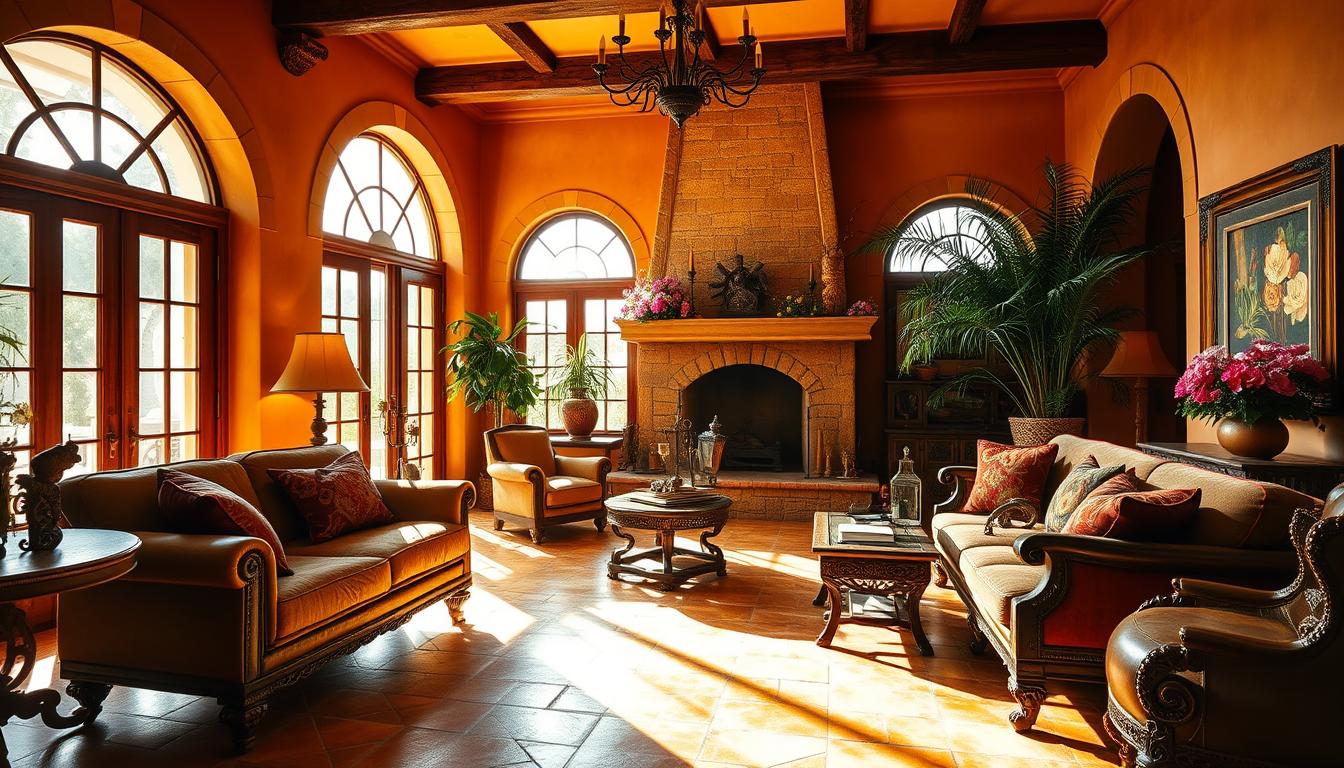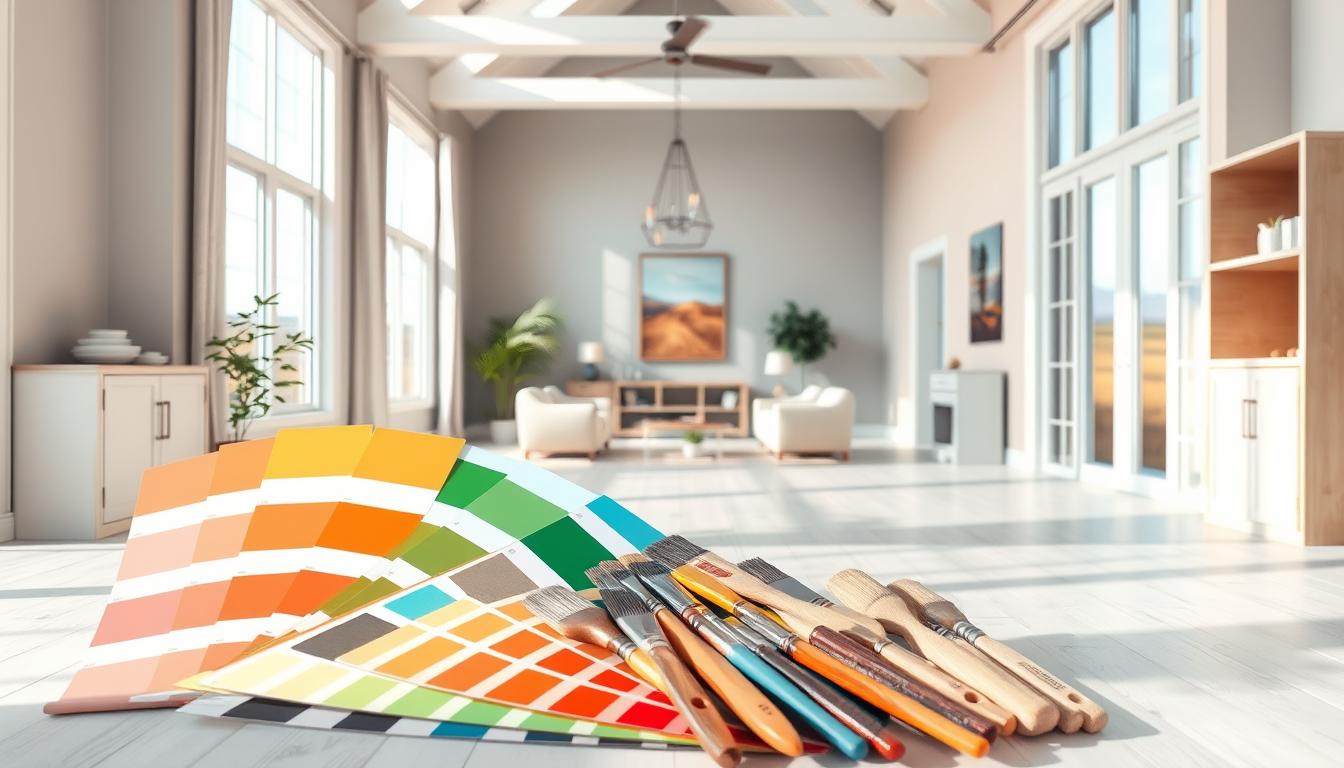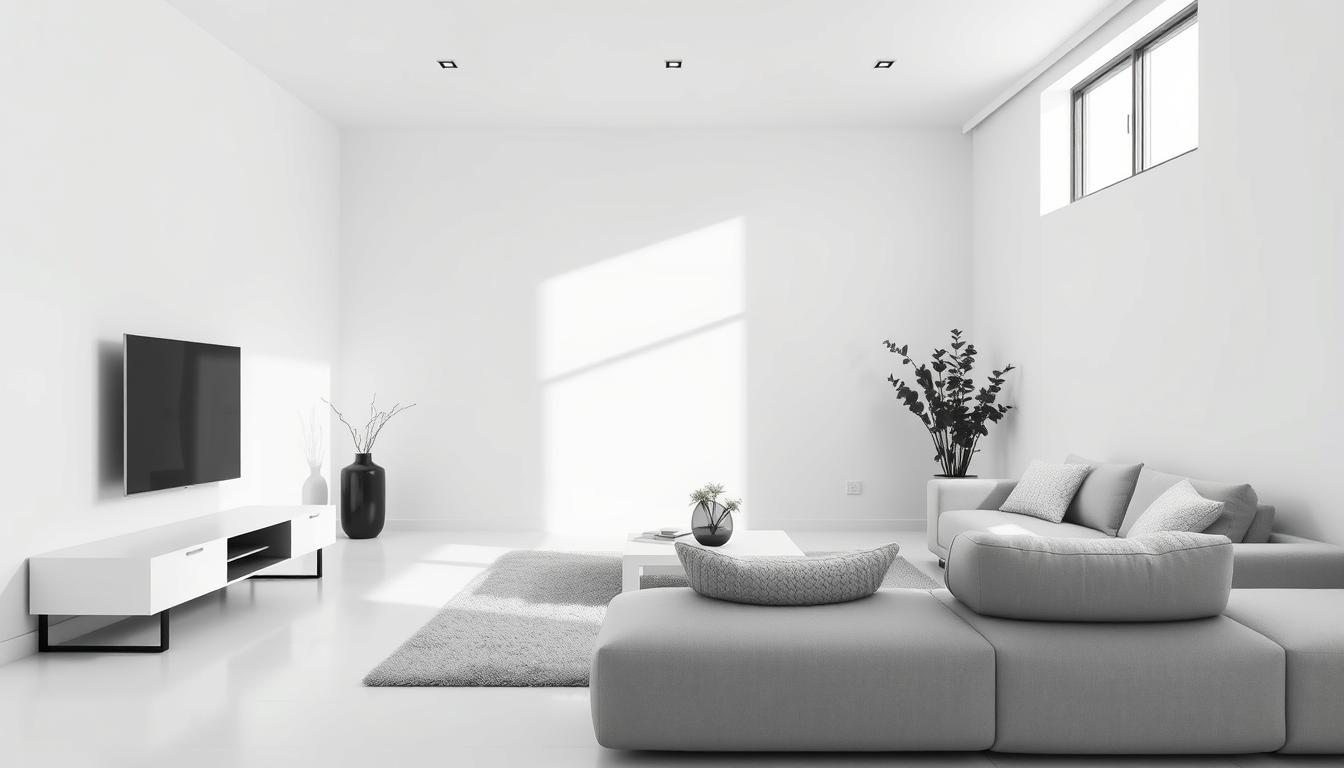Did you know that Spanish-style homes are very popular in the United States? They are known for their warm feel and deep cultural roots. Many homeowners love this style.
We will dive into what makes this decor special. We’ll look at its history, the right colors, furniture, and architectural details. By learning about these, you can make your home a true Spanish haven.
Key Takeaways
- Understand the historical influences behind Spanish decor
- Learn how to select appropriate colors and furniture
- Discover architectural features that define Spanish-style homes
- Create a warm and inviting atmosphere in your home
- Transform your living space into an authentic Spanish haven
Understanding the Essence of Spanish-Style Decor
To make a Spanish-style interior, knowing the history is key. Spanish decor is more than looks; it’s about history and culture.
Key Characteristics of Spanish-Style Interiors
Spanish interiors are warm, elegant, and full of details. They stand out because of:
- Ornate details and carved wood, showing the country’s skill
- Vibrant colors and bold patterns, from Moorish and Mediterranean styles
- Use of natural materials like stone, wood, and clay for a cozy feel
- Traditional elements like wrought ironwork and antique furniture for depth
Historical Influences on Spanish Design
Spanish design has been influenced by many styles, like Moorish, Gothic, and Renaissance. The azulejos tile work shows Moorish influence. Gothic cathedrals inspired the use of arches and vaulted ceilings.
The Renaissance brought back classical elements, like columns and detailed designs. Knowing these influences helps create a true Spanish-style interior that respects the country’s heritage.
Important historical influences on Spanish design include:
- The Moorish occupation, which introduced intricate tile work and Islamic patterns
- The Gothic period, known for grand cathedrals and arches
- The Renaissance, which revived classical elements and detailed designs
By using these historical influences in our design, we can make a Spanish-style interior that’s warm, elegant, and full of character.
Selecting the Right Color Palette
To bring the warmth of Spanish culture into your home, picking the right colors is crucial. The color palette is key in Spanish-style interiors. It captures the warmth and richness of the Spanish landscape.
Start with earthy tones for a cozy feel. These warm colors are typical of Spanish decor. They make a great base for your design.
Warm Earthy Tones to Consider
Earthy tones like terracotta, sienna, and golden brown are essential in Spanish interiors. These colors mirror the Spanish terrain’s natural beauty. They also make your space warm and welcoming.
| Color | Description | Usage |
|---|---|---|
| Terracotta | A warm, earthy red tone | Walls, decorative pots |
| Sienna | A rich, brown-red color | Flooring, furniture |
| Golden Brown | A warm, sun-kissed brown | Woodwork, accents |
Integrating Bold Accent Colors
To add depth, introduce bold accent colors. Use shades like turquoise, deep red, and cobalt blue in textiles, ceramics, and decor. This reflects Spanish culture’s vibrant spirit.
Mixing warm earthy tones with bold colors creates a vibrant palette. This blend honors Spanish culture. It also makes your space beautiful and inviting.
Flooring Options for Authenticity
Flooring is key in making a Spanish-style home feel real. The right flooring can make your space feel connected to Spain’s rich culture.
Traditional Spanish Tiles
Traditional Spanish tiles, or “azulejos,” are a big part of Spanish decor. They’re not just for floors; they add color and character. Spanish tile accents can create stunning designs that show off Spanish history and skill.
When picking Spanish tiles, think about the colors and designs that fit your space. Earthy tones and classic patterns are common in Spanish tiles. They bring warmth and authenticity to your home.
| Type of Tile | Description | Best Use |
|---|---|---|
| Terracotta Tiles | Earthy, rustic, and warm | High-traffic areas, kitchens |
| Glazed Ceramic Tiles | Colorful, decorative, and durable | Bathrooms, backsplashes |
| Mosaic Tiles | Intricate, artistic, and versatile | Decorative accents, tabletops |
Incorporating Rustic Wood Flooring
Rustic furniture and wood flooring also add to a Spanish-style home’s authenticity. Wood flooring adds warmth and coziness, fitting well with the home’s look.
Wood flooring can look rustic through techniques like distressing and hand-scraping. This look is great for living areas and bedrooms, making them feel cozy and relaxing.
When picking wood flooring, think about the wood type and finish. Reclaimed wood or wood with a natural finish adds to the rustic charm of your home.
Furniture Selection and Arrangement
Choosing and arranging furniture is key to a Spanish-style home’s charm. Pieces often have wrought iron details, carved wood, and rich fabrics. These elements create a warm, inviting feel.
Choosing the Right Pieces
Furniture for a Spanish-style home should be warm, elegant, and comfy. Look for items with wrought iron details like beds, chairs, and tables. Carved wooden pieces also add to the traditional Spanish vibe.
When picking furniture, think about these:
- Ornate carvings and intricate details
- Rich, luxurious fabrics for upholstery
- Wrought iron accents for a touch of elegance
- Dark, rich wood tones for a warm, traditional feel
Arranging for Comfort and Style
After picking your furniture, arrange it for comfort and style. Use conversational circles to foster social interaction. Make sure the space flows well for both looks and function.
Here’s a table showing furniture arrangement pros and cons:
| Layout | Pros | Cons |
|---|---|---|
| Conversational Circle | Encourages social interaction, cozy atmosphere | May limit space if too many pieces are used |
| Linear Arrangement | Creates a sense of openness, easy to navigate | Can feel less intimate or inviting |
Interior design experts say, “A successful Spanish-style interior is warm and inviting. It should feel elegant and lived-in.”
“A well-designed Spanish-style home should transport you to a different era, one of warmth and hospitality.”
Using furniture with wrought iron details and arranging it well can make your home feel Spanish. Focus on comfort, elegance, and Spanish design elements for a captivating space.
Textiles and Fabrics: Adding Depth
In Spanish decor, fabrics and textiles do more than just decorate. They add warmth and depth to a room. By using various textiles, we can make a space feel cozy, like a traditional Spanish home. This not only makes the room look better but also makes it feel warmer.
Popular Patterns in Spanish-Style Decor
Spanish interiors often use rich velvets, intricately embroidered fabrics, and bold stripes. These add visual interest and depth. We can use them in upholstery, throw pillows, and rugs.
For example, a velvet sofa with embroidered pillows and a striped rug creates a cozy atmosphere. Using textiles with traditional Spanish designs also adds to the cultural feel of the space.
Using Textiles to Enhance Texture
To add texture in a Spanish-style room, mix materials like wool, silk, and cotton. Plush throw blankets, woven baskets, and cozy terracotta floors with area rugs bring warmth. The goal is to balance textures for a harmonious space.
Textiles can also connect different areas of the home. Choosing fabrics and patterns that match can create a unified look. This not only looks good but also makes the home feel welcoming and comfortable.
Lighting Solutions for Spanish Interiors
In Spanish-style homes, lighting is key to the ambiance and warmth. It highlights architectural features and brings out decorative beauty. The right lighting can make a space feel cozy and inviting.
Natural light is a big deal in Spanish architecture. It’s often maximized with large windows and courtyards. When designing your home, think about how to use natural light. Place windows, skylights, and mirrors wisely.
Natural Light Considerations
To get the most from natural light, try these tips:
- Install big windows and sliding glass doors for natural light and views.
- Use skylights or solar tubes for light in dark spots.
- Place mirrors by windows to spread light around the room.
- Keep windows clear with sheer curtains or blinds for filtered light.
Choosing Fixtures That Complement Style
For artificial lighting, pick fixtures that fit the Spanish style. Wrought iron chandeliers or lanterns are great. They enhance the look and feel of your space. Here are some ideas:
- Wrought iron lighting, like chandeliers or sconces, for elegance and authenticity.
- Lantern-style lights for a warm glow indoors or outdoors.
- Candlelight for a cozy feel in the evenings.
Blend natural and artificial lighting for a welcoming atmosphere in your Spanish-style home. Think about the look you want and choose lighting that matches your style.
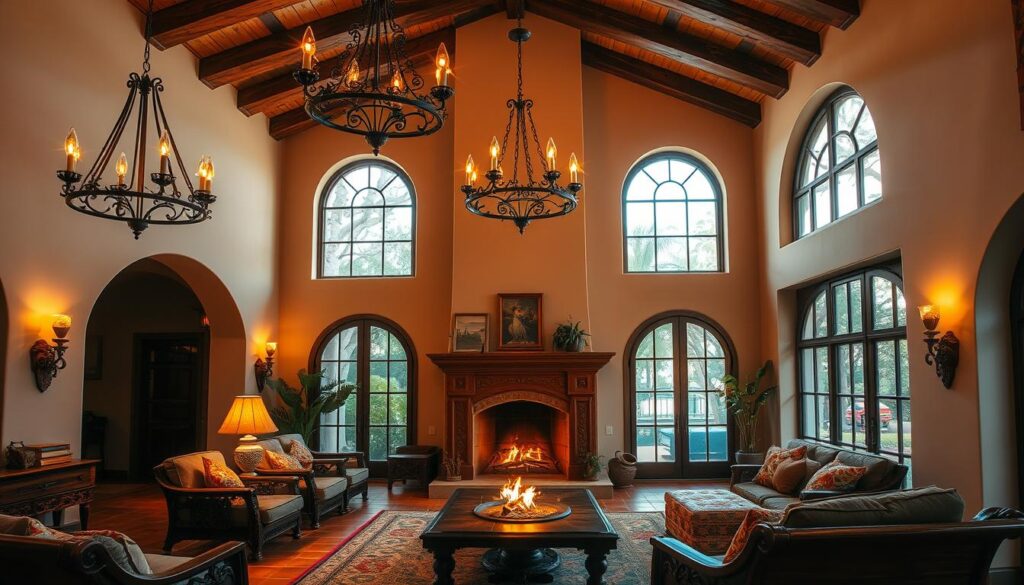
The Role of Art and Accessories
Spanish-style homes show off their rich culture through art and accessories. Adding traditional artwork and decor makes the space unique and authentic. It’s a way to make the home truly yours.
Traditional Artwork and Tiles
Traditional Spanish artwork, like religious icons and hand-painted tiles, is key to authentic Spanish decor. These items are not just pretty; they hold deep historical and cultural value. Religious icons can be hung on walls or placed on shelves, adding a spiritual feel.
Hand-painted tiles, or talavera, are a big part of Spanish decor. They can make stunning backsplashes, decorate tables, or even cover walls. Their bright colors and detailed designs bring Spanish craftsmanship into your home.
Using Accessories to Personalize Space
Accessories like vintage ceramics, wrought iron decor, and colorful textiles can really make a Spanish-style home stand out. Vintage ceramics look great on open shelves or as decorative pieces on tables and mantels.
Wrought iron decor, including candle holders and wall hangings, adds elegance. Colorful textiles, like embroidered linens and woven blankets, add warmth and texture. By choosing and placing these items carefully, you can make your home feel personal and true to Spanish style.
Bringing the Outdoors In
Spanish-style homes are known for blending indoors with outdoors. We can do the same in our homes with the right design. This connection to nature makes our spaces look better and feel more peaceful.
Courtyards and Patios Inspiration
Courtyards and patios are key parts of Spanish architecture. They link the inside to the outside. To bring this into our homes, we can use warm and bright colors. Think of terracotta, green plants, and colorful flowers.
- Use terracotta pots and planters to add warmth and character.
- Incorporate natural stone or brick elements to create a sense of authenticity.
- Hang wrought iron lanterns or decorative pieces to add a touch of elegance.
Integrating Plants and Greenery
Adding plants to our homes brings the outdoors in. Plants clean the air and make our spaces look better. They fit well with the rustic furniture and earthy tones of Spanish decor.
- Choose low-maintenance plants like succulents or ferns.
- Use rustic wooden planters or woven baskets to add texture.
- Group plants together to create a lush, verdant display.
By using natural materials, bright colors, and plants, we can make our homes welcoming. This approach celebrates the beauty of Spanish-style design.
Creating Cozy Spaces with Fireplaces
Spanish-style homes often have fireplaces that are perfect for social gatherings and warmth. A well-designed fireplace can make your living space feel cozier and more welcoming.
The type of fireplace you choose is key to creating a cozy atmosphere. Let’s look at the different types that can fit your Spanish-style home.
Traditional vs. Modern Fireplaces
Traditional wood-burning fireplaces add a rustic charm and warmth to Spanish-style homes. Modern gas fireplaces, on the other hand, offer a clean and efficient option without losing style.
Key Considerations:
- Traditional wood-burning fireplaces offer a genuine, rustic experience.
- Modern gas fireplaces are efficient and easy to maintain.
Both types can be enhanced with spanish tile accents to boost their visual appeal and match the Spanish-style decor.
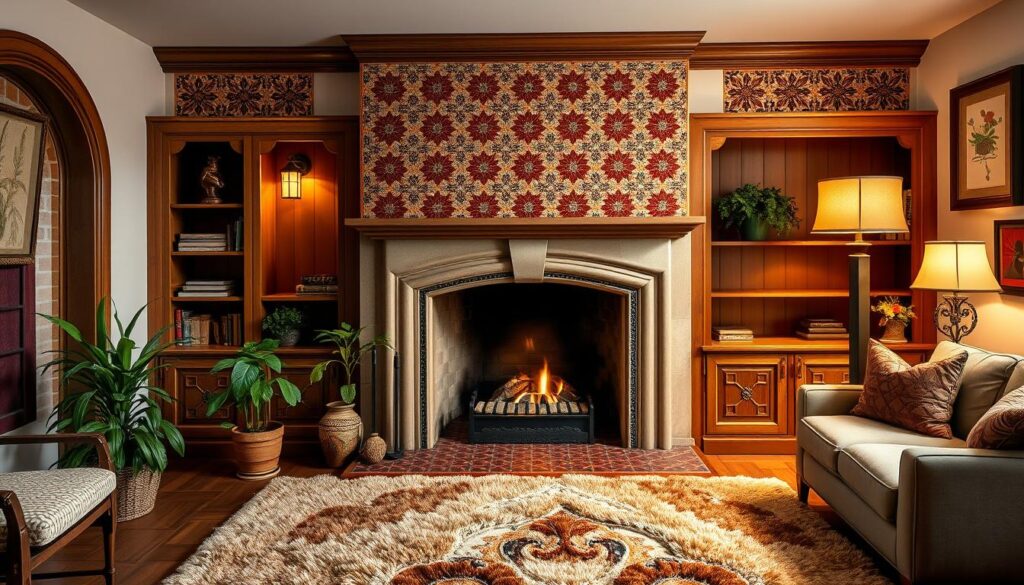
Decorating Around the Fireplace
After picking your fireplace, think about decorating the area around it. The goal is to create a look that complements the fireplace and improves the room’s ambiance.
Use carved wooden mantels, decorative tiles, and warm textiles to make the area cozy and inviting. Adding decorative accessories like vases, candlesticks, and artwork can also make the space your own.
Tips for Decorating:
- Choose warm, earthy tones to create a cozy feel.
- Add decorative tiles and spanish tile accents for visual interest.
- Use warm textiles like throw blankets and pillows to add comfort.
Incorporating Spanish-Style Architecture
Spanish-style architecture is known for its grand archways, ornate ceilings, and decorative wrought ironwork. These features make your home look beautiful and add a touch of history.
Archways and Ceilings
Archways are a key part of Spanish-style homes, often made of intricate stone or stucco. They can be found at main entrances and inside rooms. Ornate ceilings with exposed beams or decorative tiles add elegance and authenticity.
“The use of archways and ornate ceilings in Spanish-style homes creates a dramatic and elegant atmosphere,” architectural experts say. Adding these features can greatly improve your home’s look.
The Value of Courtyards and Balconies
Courtyards and balconies are essential in Spanish-style homes, blending indoor and outdoor spaces. A courtyard is a peaceful spot, while a balcony is a lovely place to enjoy the view. Adding wrought iron railings and plants makes these areas even better.
- Courtyards provide a private outdoor space for relaxation and entertainment.
- Balconies offer a charming area to enjoy the outdoors while maintaining privacy.
- Both features can be enhanced with decorative elements like wrought ironwork and terracotta pots.
By adding these architectural elements, you can make your home both grand and welcoming. Using cozy terracotta floors, along with grand archways and ornate ceilings, will give your home an authentic Spanish-style look.
Outdoor Living and Gardens
Outdoor living is key in Spanish-style homes. Gardens and courtyards feel like part of our homes. To make a true Spanish outdoor area, we must use Mediterranean design elements.
Essential Elements of a Spanish Garden
A Spanish garden uses natural materials, bright colors, and lots of plants. Key elements include:
- Olive trees and other Mediterranean plants
- Terracotta pots and tiles
- Fountains or water features
- Wrought iron furniture and decor
These add beauty and connect indoors and outdoors. This is a big part of Spanish homes.
Creating an Inviting Outdoor Space
To make our outdoor area welcoming, we need to think about layout, lighting, and furniture. Here are some tips:
- Use a mix of seating areas and open spaces for relaxation and fun.
- Add warm lighting, like string lights or lanterns, for ambiance.
- Choose furniture that’s stylish and lasts, like wrought iron or recycled wood.
With these tips, we can make an outdoor space that’s beautiful, useful, and inviting.
Let’s see how different elements come together in a Spanish-style garden:
| Element | Description | Benefit |
|---|---|---|
| Olive Trees | Mediterranean plants known for their hardiness and beauty | Adds authenticity and greenery |
| Terracotta Pots | Earth-toned pots that complement Spanish-style decor | Brings warmth and color to the garden |
| Fountains | Water features that create a soothing ambiance | Enhances the sensory experience of the garden |
By understanding and using these elements, we can make a Spanish-style outdoor living space that’s both beautiful and welcoming.
Final Touches: Personalizing Your Space
As we wrap up our guide to Spanish-style home interiors, let’s talk about the personal touches. A bright color scheme can brighten up a room. But it’s the unique details that make a house feel like home.
Making it Personal
Adding family heirlooms and personal treasures can make your Spanish-style home special. These items show off your personality and style. Think about displaying vintage finds, antique furniture, or cultural pieces that have a story to tell.
A Cohesive Look
To keep your home looking great, stick to a consistent color scheme and style. This makes each room feel connected, making your home feel bigger and more welcoming. Mixing personal touches with a unified design creates a space that’s uniquely yours.

